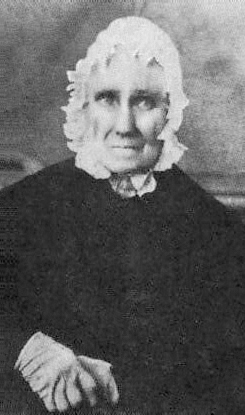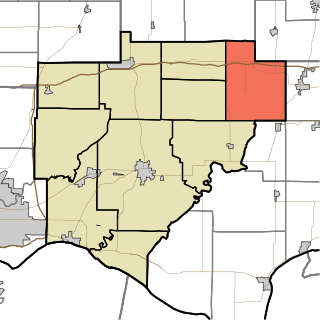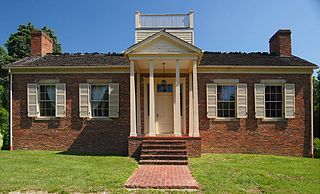
Spencer County is a county located in the U.S. state of Indiana. As of the 2020 census, the population was 19,810. The county seat is Rockport. Despite not being in the Owensboro Metropolitan Area, the entire riverfront of the city of Owensboro, Kentucky borders the southern tip of the county.

Alum Creek is a census-designated place (CDP) in Kanawha and Lincoln counties along the Coal River in the U.S. state of West Virginia. It includes the unincorporated communities of Alum Creek, Forks of Coal, and Priestley. The CDP had a population of 1,749 at the 2010 census, down from 1,839 at the 2000 census.
Lincoln City is an unincorporated community in Carter Township, Spencer County in the southwestern part of the U.S. state of Indiana. It lies five minutes south of Interstate 64, northeast of Evansville, and approximately twenty miles north of the Ohio River.

Thomas Lincoln Sr. was an American farmer, carpenter, and father of the 16th president of the United States, Abraham Lincoln. Unlike some of his ancestors, Thomas could not write. He struggled to make a successful living for his family and faced difficult challenges in Kentucky real estate boundary and title disputes, the early death of his first wife, and the integration of his second wife's family into his own family, before making his final home in Illinois.

Nancy Hanks Lincoln was the mother of U.S. President Abraham Lincoln. Her marriage to Thomas Lincoln also produced a daughter, Sarah, and a son, Thomas Jr. When Nancy and Thomas had been married for just over 10 years, the family moved from Kentucky to western Perry County, Indiana, in 1816. When Spencer County was formed in 1818, the Lincoln Homestead lay within its current boundaries. Nancy Lincoln died from milk sickness or consumption in 1818 at the Little Pigeon Creek Community in Spencer County when Abraham was nine years old.

Abraham Lincoln Birthplace National Historical Park is a designated U.S. historic park preserving two separate farm sites in LaRue County, Kentucky, where Abraham Lincoln was born and lived early in his childhood. He was born at the Sinking Spring site south of Hodgenville and remained there until the family moved to the Knob Creek Farm northeast of Hodgenville when he was two years old, living there until he was seven years of age. The park's visitor center is located at the Sinking Spring site.

Lincoln Boyhood National Memorial is a United States presidential memorial and a National Historic Landmark District in Lincoln City, Indiana. It preserves the farm site where Abraham Lincoln lived with his family from 1816 to 1830. During that time, he grew from a 7-year-old boy to a 21-year-old man. His mother, Nancy Hanks Lincoln, and at least 27 other settlers were buried here in the Pioneer Cemetery. His sister Sarah Lincoln Grigsby was buried in the nearby Little Pigeon Baptist Church cemetery, across the highway at Lincoln State Park.

Sarah Bush Lincoln was the second wife of Thomas Lincoln and stepmother of Abraham Lincoln. She was born in Kentucky to Christopher and Hannah Bush. She married her first husband, Daniel Johnston, in 1806, and they had three children. Daniel Johnston died in 1816, and in 1819, she married widower Thomas Lincoln, joining his family with her three children.

Lincoln State Park is a state park of Indiana, United States. It is located in southern Indiana in Spencer County approximately 35 miles (56 km) east of Evansville.

Pigeon Roost State Historic Site is located between Scottsburg and Henryville, Indiana, United States. A one-lane road off U.S. Route 31 takes the visitor to the site of a village where Native Americans massacred 24 settlers shortly after the War of 1812 began.

Pigeon Township is one of ten townships in Warrick County, Indiana, United States. As of the 2010 census, its population was 979 and it contained 436 housing units.

Pigeon Creek is a tributary of the Ohio River in southwestern Indiana. It runs approximately 47.5 miles (76.4 km) from its eastern source in rural Gibson County near Princeton and its western source near Owensville. The forks merge southeast of Fort Branch, and from there it heads southeast under its new northern crossing of Interstate 69 towards Warrick County near Lynnville. From there it heads south, under Interstate 64, where it is signed as the "Wabash and Erie Canal" instead of as Pigeon Creek. The creek becomes larger as the Little and Big Bluegrass Creeks empty into it in western Warrick County. The larger creek then turns west crossing into Vanderburgh County under its older former Interstate 164 crossing, now also part of Interstate 69, just north of Evansville's East Side. The creek has a few more tributaries join as it first heads west through Evansville's East and North Sides then south between Downtown Evansville and Westside Evansville, where it empties into the Ohio River.
Jesse LaFollette was the grandfather of Robert Marion La Follette, Sr., William La Follette, and Harvey Marion LaFollette. His family lived next to the Knob Creek Farm, Kentucky owned by Thomas Lincoln during Abraham Lincoln's boyhood years. LaFollette is shown in one of the limestone panels at the Lincoln Boyhood National Memorial in Lincoln City, Indiana.
The Lincoln Trail State Memorial is a sculpture group designed in 1937 by Nellie Verne Walker and erected in 1938 to commemorate the first entrance of Abraham Lincoln, then a destitute 21-year-old frontiersman, into Illinois. It is located at the west end of the Lincoln Memorial Bridge on U.S. Route 50 Business in rural Lawrence County, approximately 11 miles (18 km) east of Lawrenceville.

Little Pigeon Creek Community, also known as Little Pigeon Creek Settlement and Little Pigeon River settlement, was a settlement in present Carter and Clay Townships in Spencer County, Indiana along Little Pigeon Creek. The community, near present-day Lincoln City, Indiana, was established on frontier land by 1816. There were enough settlers in the Indiana wilderness to enable Indiana to become a state in December, 1816.
Pigeon is an unincorporated community in Jackson Township, Spencer County, in the U.S. state of Indiana.

Colonel William Jones House, also known as William Jones State Historic Site, is a historic house in Gentryville and the Lincoln State Park in Jackson Township, Spencer County, Indiana. It was listed on the National Register of Historic Places on May 12, 1975. William Jones (1803–1864) was a farmer, merchant, soldier, and politician.

Lincoln Pioneer Village is a memorial along the Ohio River in Rockport, Spencer County, Indiana to President Abraham Lincoln who lived in the county during his boyhood years. It was built in 1934 and 1935 in the city park by the Works Progress Administration. George Honig, an artist and sculptor from Spencer County, designed the memorial. He also oversaw the building of the pioneer village replica, which was sponsored by the Spencer County Historical Society and the Rockport City Council. It was listed as a historic district on the National Register of Historic Places on April 20, 1998.
Loafers Station was a community in Pigeon Township, Warrick County, in the U.S. state of Indiana.












